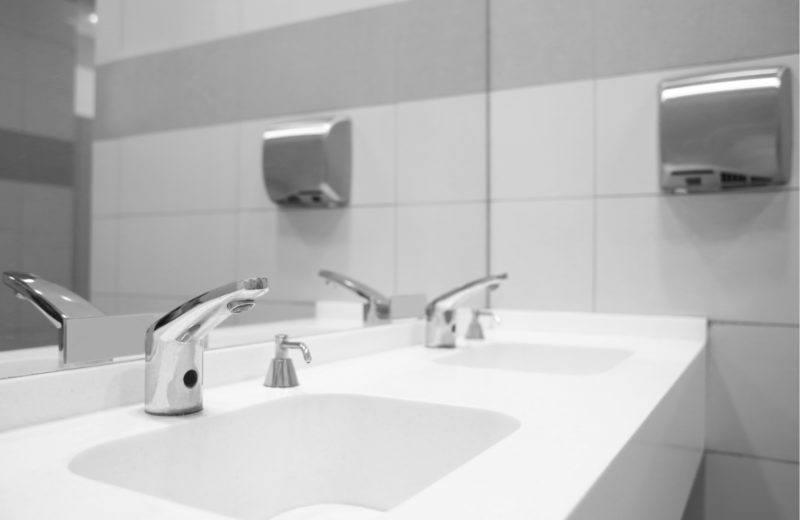Rethink the Disease-Spreading Hand Dryer in a Pandemic

Pandemics are difficult to address precisely because of the vast information uncertainties they entail. As the ongoing coronavirus crisis reveals, broad and sweeping policy responses to the disease are often premised on deeply uncertain and even flawed data assumptions, as well as a propensity to understate the unintended costs of a society-wide shutdown. We should not, however, mistake this uncertainty for a reason to do nothing, and in fact small policy changes on the margin could go a long way toward mitigating the spread of this and other viruses.
One such solution that I’ve long argued for is the elimination of those ubiquitous electric hand dryers in public restrooms. Though they were once touted as a health-improving “hands free” alternative to paper towels, electric hand dryers also have the unintended effect of broadcasting millions of microscopic particles into the air with every blast. Without going into too much detail, you can easily imagine how these mechanized atomizers do not mix well with the typical uses of a public restroom, given what we know about the risks of airborne disease transmission.
Decades of scientific research attest to dangers presented by electric hand dryers in spreading bacterial and viral agents. In fact, medical experts often strongly advise against their installation in hospitals and other healthcare facilities.
One recent study examined 120 air sample tests taken in the proximity of various hand-drying techniques after coating participants’ hands with a benign bacterial agent. It found that airborne bacterial dispersion was substantially higher with both conventional hot air dryers and high-tech jet air dryers than old-fashioned paper towels.
The problem comes from how these machines essentially aerosolize infectious agents from their users’ hands, as well as unclean surfaces from the surrounding bathroom. The effect is akin to setting off an airborne bomb of viruses and bacteria inside a restroom, with mounting evidence showing that they also quickly disperse throughout the attached buildings.
Another study of 36 bathrooms in an office building environment experimented with shutting off the hand dryers for an 18-hour period to compare against bacterial samples collected when they were operational. They found three to ten times as many bacterial colonies, on average, on test plates from when the air dryers were on, as compared to paper towels.
Even high-tech improvements to air dryers fail to address this problem. The same study examined dryers fitted with particle-removing HEPA filters and found a noticeable reduction compared to unfiltered dryers, but still found evidence that they spread pathogens from the surrounding air. The authors conclude that HEPA filters “most likely reduce the number of potentially pathogenic bacteria with the potential to colonize hands but do not eliminate the risk entirely.”
A different study found similar evidence of the dangers posed by both older conventional hot air dryers and newer high-tech models such as the Dyson airblade, this time using a non-infectious virus in its dispersion test. Researchers dipped their hands in a liquid containing the virus, then washed and dried them using paper towels, a conventional hot air dryer, and the high-tech jet dryer. They then measured its dispersion onto cardboard test surfaces placed at various distances from the sink or dryer.
The results strongly suggested that conventional paper towels yielded the lowest level of viral dispersion. As for the high-tech Dyson airblade, its intense high-speed air blasts actually dispersed the virus further than the conventional model (the manufacturer disputes these findings, but their response thus far has come in the form of a YouTube video campaign accusing their critics of taking funding from the paper towel industry). The results however have independent confirmation, including the aforementioned study that tested bacterial agents from 120 air samples using different drying techniques.
With mounting scientific evidence pointing to the hygiene and public health risks of both conventional and high-tech air dryers in restrooms, we might legitimately ask why they still enjoy such widespread use. The answer, it turns out, is at least in part a political one. Air dryers have long been favored by environmentalist activists, who tout their lower carbon footprint than the waste-producing paper towel industry.
Over the last few years, environmental researchers have churned out a multitude of studies touting the claimed environmental benefits of electric hand dryers in reducing paper waste. One of the studies (ironically commissioned by Dyson) argues that conventional paper towels create 70% more carbon emissions than air dryers. They recommend the dryers, both conventional and high-tech, as necessary means of staving off global warming.
Several air dryer manufacturers have sought to capitalize on the political trendiness of “going green” to counter the public health concerns surrounding their products. This includes obtaining Carbon Trust certification for air dryers, as well as ensuring that the devices qualify for LEED certification credits under the U.S. Green Building Council’s environmental architecture rating system.
Environmental appliance, construction, and architectural ratings are ostensibly private regulatory mechanisms. But they often take advantage of symbiotic partnerships with government officials who incentivize or even mandate compliance with these privately set standards as a condition for building construction or conducting business in a designated city or town.
Governments across the world have started to incorporate these and other “private” carbon neutrality certifications into their conditions for contracting and product procurement. Dozens of locales now require LEED certification in government-contracted construction and some cities such as San Francisco even mandate LEED compliance in new commercial and residential structures.
Since air dryers qualify as carbon-reducing alternatives to paper towels, these policies effectively incentivize the installation of this disease-spreading technology in public spaces – sometimes by force of law. The upshot of both the private regulatory certifications and public policies designed to enforce them is a direct tradeoff between “going green” in new building construction and deploying an unsanitary form of technology that appears to have significant public health risks.
In a time of extreme public health consciousness, as we are currently experiencing due to the coronavirus epidemic, reconsidering these policies represents an easy and attainable margin for reducing disease transmission. A minor and symbolic carbon offset is not a luxury we can afford when it poses a potentially major public health risk. It’s time to pull the plug on electric hand dryers once and for all.











